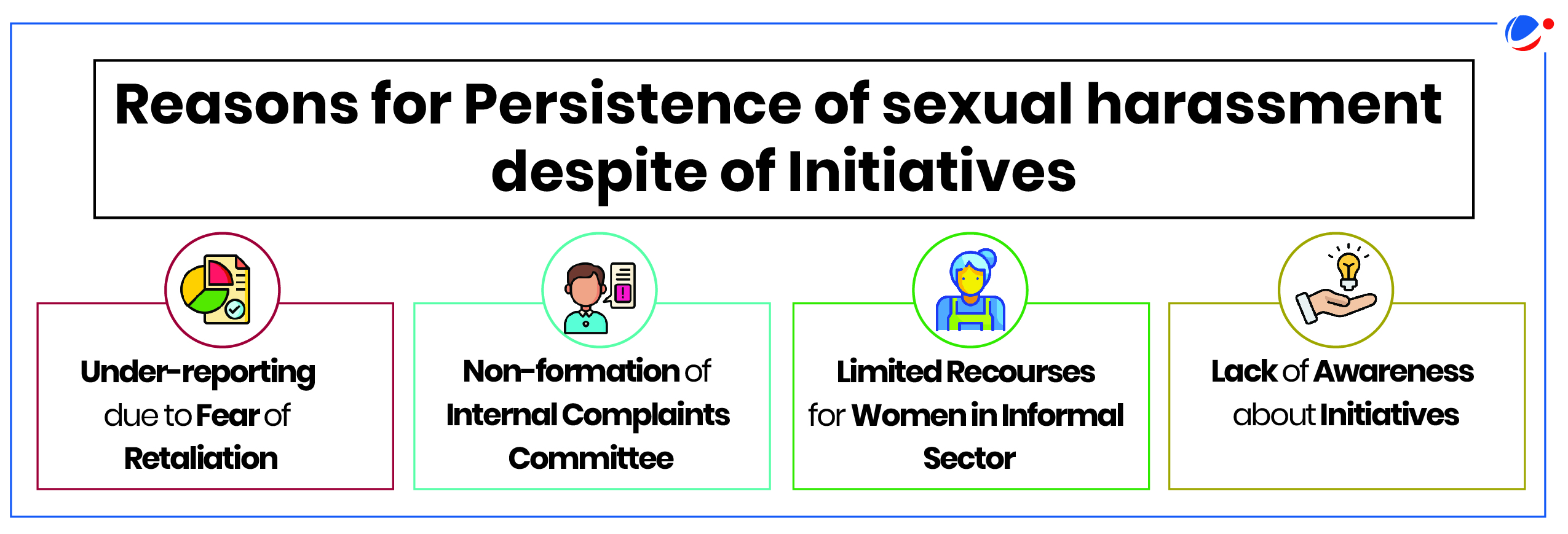Why in the News?
Recently the Justice Hema Committee report revealed exploitation and sexual harassment of women and gender inequality in the Malayalam film industry.
Sexual Harassment at Workplace
- Definition: It refers to any unwelcome sexual advance, demand for sexual favors, or other verbal or physical conduct of a sexual nature that occurs at workplace.
- Over 419 cases, or about 35 per month, were reported in the country in 2022 (National Crime Records Bureau data).
- Types: Sexual Harassment has traditionally been divided into two well-known forms.
- Quid Pro Quo: Involves seeking sexual favors or advances in exchange for work benefits such as promises of promotion, higher pay, etc.
- Hostile Work Environment: Involves subjecting employees to pervasive or severe unwanted sexual behavior that creates an offensive, intimidating, or abusive workplace.
- E.g., sexual jokes, inappropriate touching etc.

Impact of Sexual Harassment at Workplace
On Individuals
- Career Disruption: It creates an unsafe and hostile work environment, impeding women's professional growth and affecting their overall well-being.
- Health Impact: Victims of sexual harassment often experience heightened levels of stress and anxiety and suffer from diminished self-worth and confidence.
- Violation of Fundamental rights of women: Sexual harassment of Women at workplace is a form of gender discrimination. It violates women's right to equality under Article 14 and 15 and right to life and live with dignity under Article 21 of the Constitution.
On Workplace
- Toxic Work Culture: Sexual harassment can entrench toxic workplace cultures that normalize discrimination, bullying, and inappropriate behavior, making the environment unsafe and non-inclusive for women.
- Decline in Productivity: Sexual harassment often impact organizational efficiency and financial performance.
On Society
- Perpetuation of gender Inequality: Sexual harassment disproportionately affects women, reinforcing gender inequality by discouraging women's career growth and professional development.
- Lower women workforce participation: When women leave their jobs or careers due to harassment it lowers their representation in total workforce.
- Harassment-related job changes or career disruptions also contribute to the gender pay gap.
Initiatives Undertaken
- Vishaka Guidelines (1997): These guidelines were laid down by the Supreme Court of India in response to the Vishaka vs. State of Rajasthan case.
- Prior to the POSH Act, the Vishaka Guidelines were the first significant step toward addressing workplace sexual harassment in India.
- Sexual Harassment of Women at Workplace (Prevention, Prohibition and Redressal) Act, 2013 (POSH Act): Aims to prevent and address incidents of sexual harassment of women at their place of work and provide a mechanism for redressal of complaints related to such harassment.
- It provides for Internal Complaints Committee (ICC) and Local Complaints Committees to handle complaints of sexual harassment.
- Sexual Harassment electronic -Box (She-Box): Online complaint management system for registering complaints related to Sexual Harassment at workplace launched by Ministry of Women & Child Development in 2017.
- Convention on the Elimination of All Forms of Discrimination against Women: International convention which recognizes protection against sexual harassment and right to work with dignity as universal human rights.
- India ratified the convention in 1993.

Way Forward
- Strengthening Implementation of the POSH Act: By conducting random audits to ensure that companies have set up ICCs and introducing stricter penalties on organizations that fail to comply.
- Local Complaints Committees should be made more accessible to women in informal sector.
- Promoting Gender Equality in the Workplace: Gender diversity in senior positions helps dismantle patriarchal structures and reduces the occurrence of harassment.
- Collaboration with Civil Society groups: In educating and supporting women, especially in informal sector, such as agriculture and domestic work.
- Recommendations of Hema Committee:
- Femininity to be divorced from passiveness and silent suffering.
- Characterisation of Women in cinema: Depicting as holders of powerful positions like Civil Servants, Ambassadors, leaders, etc.
- Gender Awareness Training Program: Challenging the monopoly of power enjoyed by men; projecting women equal to men.
- Redefining Masculinity and Femininity: Masculinity to be equated to justice, equality, and compassion instead of violence and aggression.
- Creation of a Welfare Fund: For the support of women in job break due to childbearing, health or other responsibilities.








